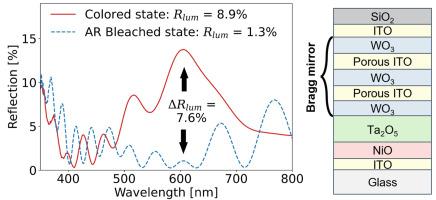抗反射到镜面的全固态电致变色器件
IF 4.2
3区 材料科学
Q2 MATERIALS SCIENCE, MULTIDISCIPLINARY
引用次数: 0
摘要
无机电致变色(EC)材料能够在外加电流下在漂白和有色状态之间转换,在智能窗户和眼镜行业具有巨大的潜力。这些材料可以集成到由两个电极组成的全固态器件(assd)中,其中三氧化钨(WO3)和氧化镍(NiO)作为互补的EC层,由离子导体分开。虽然标准架构能够实现显著的传输和吸收调制,但它们在着色时实现大幅反射增加的能力仍然有限,这可能对增强美学和改善用户舒适度感兴趣。为了解决这一限制,采用了由WO3和氧化铟锡(ITO)交替层组成的EC布拉格反射镜来取代标准结构中的单一WO3层。这种改进的设计增强了ASSD反射调制,通过达到7.6%的反射增加,有效地从抗反射状态过渡到镜面状态。通过省略抗反射约束,简化了ASSD结构,该设备能够达到更高的反射调制,最高可达17.9%。采用基于传递矩阵计算的建模方法对制备的assd在漂白和有色状态下的光学行为进行了预测。尽管光谱拟合中存在一些差异,但明显峰的存在证实了Bragg镜集成EC器件的有效性。最后,耐久性测试表明,增强器件的循环稳定性在很大程度上取决于所施加的电极电位,这突出了它们在保持性能方面的关键作用。本文章由计算机程序翻译,如有差异,请以英文原文为准。

Antireflective-to-mirror-like all-solid-state electrochromic devices
Inorganic electrochromic (EC) materials, capable of transitioning between bleached and colored states under an applied current, hold significant potential for smart windows and eyewear industries. These materials can be integrated into all-solid-state devices (ASSDs) consisting of two electrodes, with tungsten trioxide (WO3) and nickel oxide (NiO) as complementary EC layers, separated by an ion conductor. While standard architectures enable significant transmission and absorption modulation, their ability to achieve a substantial reflection increase upon coloration remains limited, which can be of interest for enhanced aesthetics and improved user comfort. To address this limitation, an EC Bragg mirror composed of alternating layers of WO3 and indium tin oxide (ITO) was implemented to replace the single WO3 layer in the standard architecture. This improved design enabled enhanced ASSD reflection modulation, effectively transitioning from an antireflective to a mirror-like state by reaching a 7.6 % increase in reflection. Simplifying the ASSD structure by omitting the antireflective constraints, the devices were able to reach an even greater reflection modulation of up to 17.9 %. A modeling approach based on transfer matrix calculations was employed to predict the optical behavior of the fabricated ASSDs in both their bleached and colored states. Despite some discrepancies in the spectral fitting, the presence of a distinct peak confirmed the effectiveness of Bragg mirror-integrated EC devices. Finally, durability testing revealed that the cycling stability of the enhanced devices strongly depends on the applied electrode potentials, highlighting their critical role in maintaining performance over time.
求助全文
通过发布文献求助,成功后即可免费获取论文全文。
去求助
来源期刊

Optical Materials
工程技术-材料科学:综合
CiteScore
6.60
自引率
12.80%
发文量
1265
审稿时长
38 days
期刊介绍:
Optical Materials has an open access mirror journal Optical Materials: X, sharing the same aims and scope, editorial team, submission system and rigorous peer review.
The purpose of Optical Materials is to provide a means of communication and technology transfer between researchers who are interested in materials for potential device applications. The journal publishes original papers and review articles on the design, synthesis, characterisation and applications of optical materials.
OPTICAL MATERIALS focuses on:
• Optical Properties of Material Systems;
• The Materials Aspects of Optical Phenomena;
• The Materials Aspects of Devices and Applications.
Authors can submit separate research elements describing their data to Data in Brief and methods to Methods X.
 求助内容:
求助内容: 应助结果提醒方式:
应助结果提醒方式:


